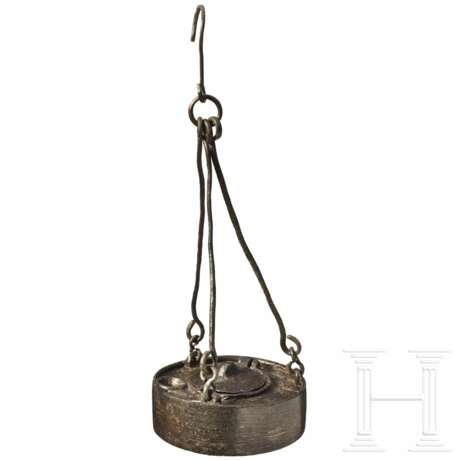ID 1323331
Lot 4120 | Öllampe, frühbyzantinisch, 5. - 7. Jhdt.
Zylindrischer Korpus, auf Drehbank abgedreht. Zentrierloch auf Unterseite, Drehrillen auf Boden und Wandung. Oberseite nach innen abgesetzt mit Randleisten um Außenkante, Dochtloch und Ölloch. Letzteres durch Deckel mit Scharnier und Dorn zum Anheben verschlossen. Am Rand drei Ösen für dreischenklige Aufhängevorrichtung aus Draht. Oben zusammengefasst durch Ring, darüber Haken. Dunkle Patina, unter welcher der teils metallische Untergrund durchschimmert. Länge im aufgehängten Zustand 17,3 cm. Breite 6,4 cm.
Provenienz: Frankfurter Privatsammlung. Erworben bei Hermann Historica im April 2016 (Auktion 72, Los 4625). Zuvor süddeutsche Privatsammlung, erworben in den 1990er Jahren im Kunsthandel.
An early Byzantine oil lamp, 5th - 7th century
An early Byzantine oil lamp, 5th - 7th century
Zylindrischer Korpus, auf Drehbank abgedreht. Zentrierloch auf Unterseite, Drehrillen auf Boden und Wandung. Oberseite nach innen abgesetzt mit Randleisten um Außenkante, Dochtloch und Ölloch. Letzteres durch Deckel mit Scharnier und Dorn zum Anheben verschlossen. Am Rand drei Ösen für dreischenklige Aufhängevorrichtung aus Draht. Oben zusammengefasst durch Ring, darüber Haken. Dunkle Patina, unter welcher der teils metallische Untergrund durchschimmert. Länge im aufgehängten Zustand 17,3 cm. Breite 6,4 cm.
Provenance: Frankfurter Privatsammlung. Erworben bei Hermann Historica im April 2016 (Auktion 72, Los 4625). Zuvor süddeutsche Privatsammlung, erworben in den 1990er Jahren im Kunsthandel.
Condition: II -
| Auction house category: | Byzantium and the Middle Ages in Southeastern Europe |
|---|
| Auction house category: | Byzantium and the Middle Ages in Southeastern Europe |
|---|
| Address of auction |
Hermann Historica Bretonischer Ring 3 85630 Grasbrunn / München Germany | ||||||||||||||
|---|---|---|---|---|---|---|---|---|---|---|---|---|---|---|---|
| Preview | |||||||||||||||
| Phone | +49 (0)89 5472 649 0 | ||||||||||||||
| Fax | +49 (0)89 5472 64999 | ||||||||||||||
| Buyer Premium | 25 % | ||||||||||||||
| Conditions of purchase | Conditions of purchase | ||||||||||||||
| Business hours | Business hours
|



